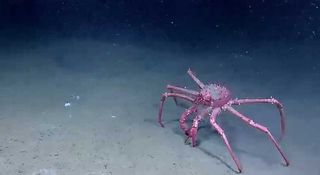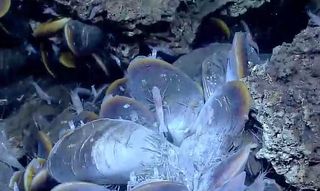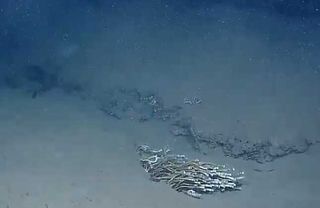
Watch Live: Robot Sends Back Footage of Deep-Sea Sights

This month, you can take a ride to a mysterious world of tube worms, strange fish and impressive crustaceans that dwell deep in the Gulf of Mexico, all without ever leaving your desk.
A National Oceanic and Atmospheric Administration expedition is at sea through the end of April, sending deep-diving robots to explore the deep-sea habitats in the northern Gulf of Mexico.
A live feed from a camera affixed to the remotely operated vehicle Little Hercules is available on the Web, complete with the commentary of the scientists who are directing the ROV from the research vessel Okeanos Explorer.
Dives to depths of up to 5,000 feet (1,500 meters) are on the schedule.

On a dive on Thursday afternoon (April 12), the scientists were in search of methane seeps — places where cold waves of hydrocarbons bubble up from the seafloor. Bacteria feed on the hydrocarbons, and in turn provide a food source for a host of strange creatures that survive in an ecosystem fueled not by the energy of the sun but by chemicals issuing up from the Earth.
The ecosystems are similar to those found at hydrothermal vents — fissures in the ocean's crust that, fueled by volcanic activity, spew forth super-heated, chemical-laden water that supports strange communities of organisms, from eyeless shrimp to yeti crabs.
As Little Hercules flew above the ocean floor, wide swaths of bare sand would suddenly give way to clusters of mussels and tube worms.
Sign up for the Live Science daily newsletter now
Get the world’s most fascinating discoveries delivered straight to your inbox.

At one point, as the camera zoomed in on what the researchers thought might be a dead colony of tube worms, something moved. "There we go, he is alive!" a scientist said.
On dive days, the ROV keeps busy. It is hoisted off the deck of the ship and lowered into the water around 8 a.m. ET and brought back to the surface at 5 p.m. ET.
It can take from 45 minutes to three hours for the ROV to reach the bottom, depending on the depth of the dive, so the view can be a bit dull sometimes, just marine "snow" — tiny bits of decomposing plants and animals that fall to the seafloor — and dark water. But the views at the bottom are worth the wait.
You never know what the scientists might find.
The expedition has been at sea since Feb. 27 and is scheduled to conduct the final ROV dive on April 28.
Reach Andrea Mustain at amustain@techmedianetwork.com. Follow her on Twitter @AndreaMustain. Follow OurAmazingPlanet for the latest in Earth science and exploration news on Twitter @OAPlanet and on Facebook.
